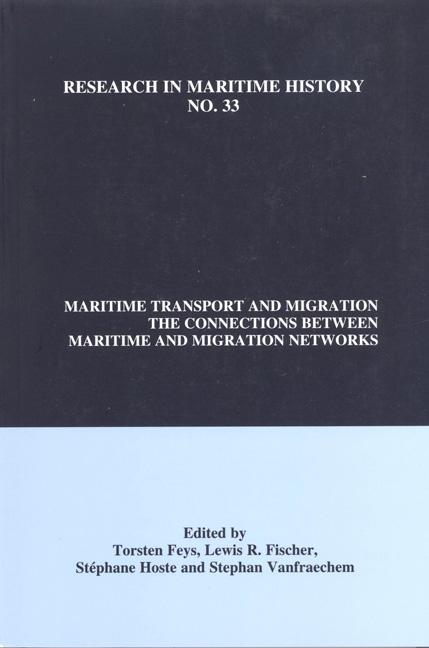Book contents
- Frontmatter
- Contents
- Contributors' Notes
- “Migration and Maritime Networks in the Atlantic Economy: An Introduction”
- “The First Waves of Internationalization: A Comparison of Early Modern North Sea and Nineteenth-Century Transatlantic Labour Migrations”
- “The Battle for the Migrants: The Evolution from Port to Company Competition, 1840-1914”
- “The Role of Foreign-bora Agents in the Development of Mass Migrant Travel through Britain, 1851-1924”
- “Transatlantic Emigration and Maritime Transport from Greece to the US, 1890-1912: A Major Area of European Steamship Company Competition for Migrant Traffic”
- “The ‘Relatives and Friends Effect:’ Migration Networks of Transatlantic Migrants from the Late Habsburg Monarchy”
- “Crossing the Last Frontier: Transatlantic Movements of Asian Maritime Workers, c. 1900-1945”
- “Costs, Risks and Migration Networks between Europe and the United States, 1900-1914”
- “Conclusion”
“Crossing the Last Frontier: Transatlantic Movements of Asian Maritime Workers, c. 1900-1945”
- Frontmatter
- Contents
- Contributors' Notes
- “Migration and Maritime Networks in the Atlantic Economy: An Introduction”
- “The First Waves of Internationalization: A Comparison of Early Modern North Sea and Nineteenth-Century Transatlantic Labour Migrations”
- “The Battle for the Migrants: The Evolution from Port to Company Competition, 1840-1914”
- “The Role of Foreign-bora Agents in the Development of Mass Migrant Travel through Britain, 1851-1924”
- “Transatlantic Emigration and Maritime Transport from Greece to the US, 1890-1912: A Major Area of European Steamship Company Competition for Migrant Traffic”
- “The ‘Relatives and Friends Effect:’ Migration Networks of Transatlantic Migrants from the Late Habsburg Monarchy”
- “Crossing the Last Frontier: Transatlantic Movements of Asian Maritime Workers, c. 1900-1945”
- “Costs, Risks and Migration Networks between Europe and the United States, 1900-1914”
- “Conclusion”
Summary
It is well known that the introduction of steam in international merchant shipping coincided with a rapid increase in the employment of Asian maritime workers. Foreign-born labour was especially prominent on British vessels after the Navigation Laws were repealed, accounting by 1891 for more than a fifth of the crews. This proportion rose to nearly one-third in 1904 before declining to about twenty-seven percent on the eve of World War I. By the early years of the twentieth century foreign crews on British vessels largely came from southern Europe, Asia, Africa and the Caribbean. Though there were Arabs, Malays and Sinhalese as well, the majority of Asian seamen came from India, followed by China. Britain was not the sole employer of Asian men, who also worked on French, German, Italian, Dutch, Norwegian and other vessels.
This essay focuses on an Asian maritime “migration” network that linked Asia and the US through Europe. (I use the term “migration” because in legal terms Asian seafarers staying on in the US were not migrants.) It is based on my research on Indian seafarers in the British merchant marine and reflects this bias. In 1891, ten percent (or 24,000) seamen on board British vessels were roughly classified as “lascars.” Though commonly understood to describe seamen from India, “lascars” was still a fluid category that included many Chinese, Arab and African seamen. This fluidity did not disappear until the 1920s, though by 1914 Chinese and Arab seamen were largely excluded from the definition unless they happened to have signed on under special contracts (or “articles of agreements”) known as “lascar articles.” By 1914 there were some 52,000 Indian seamen by this stricter definition, representing 17.5 percent of the total employment on British vessels. According to an admittedly unreliable source, the fleet also employed an estimated 8000 Chinese seamen.
The numbers of Indian seamen remained stable during the First World War or declined slightly because of competition from safer shore jobs in India and Mesopotamia. But the employment of Chinese seamen rose sharply during the same period. British vessels employed over 50,000 Indian seamen on the eve of the depression, about 40,000 during the 1930s and nearly 60,000 at the height of the Second World War.
- Type
- Chapter
- Information
- Maritime Transport and MigrationThe Connections Between Maritime and Migration Networks, pp. 97 - 112Publisher: Liverpool University PressPrint publication year: 2007



